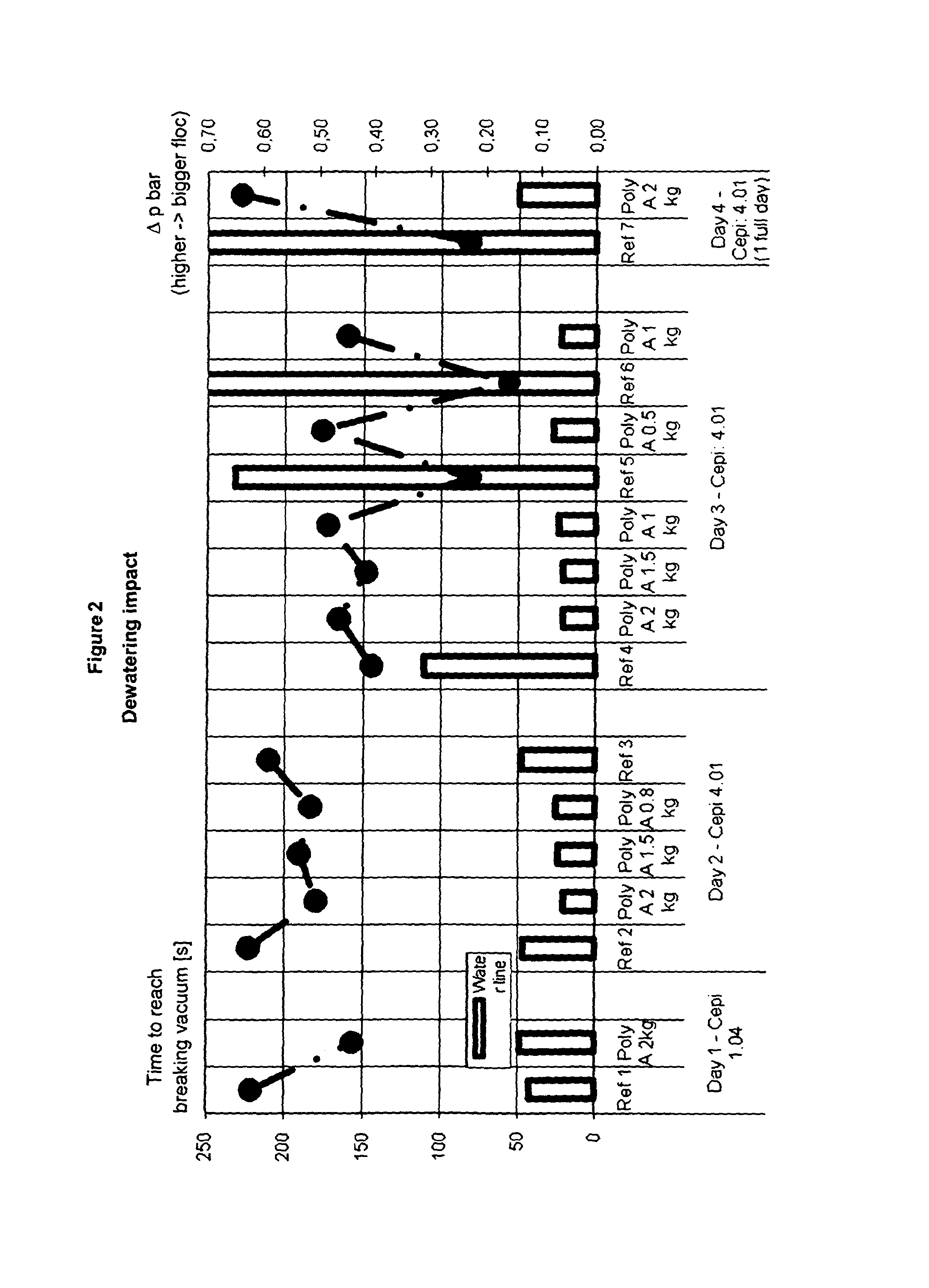Method for increasing the advantages of starch in pulped cellulosic material in the production of paper and paperboard
a cellulosic material and pulped technology, applied in the field of paper or paperboard manufacturing, can solve the problems of biocides interfering with enzymes, ineffective, unreliable and expensive processes, and chemical pollution of water, and achieve the effects of reducing whitewater turbidity, preventing microbiological degradation of starch contained, and reducing whitewater solids
- Summary
- Abstract
- Description
- Claims
- Application Information
AI Technical Summary
Benefits of technology
Problems solved by technology
Method used
Image
Examples
example 1
Using Setting A (Experiments Showing the Effects on Microbial Degradation and Starch Fixation on Cellulose when Using (a) Aux. Poly A but Neither Biocide Nor Poly A; (b) Aux. Poly A and Biocide, but no Poly A; and (c) Aux. Poly A, Biocide and Poly A)
[0462]The positive impact of the combined use of a biocide and a cationic polymer according to the invention was studied by the following experiment.
[0463]The biocide employed was a combination of an oxidizing two-component biocide comprising (a) 35% NH4Br and 13% NaOCl as an inorganic biocide, prepared in situ according to EP-A 517 102, EP 785 908, EP 1 293 482 and EP 1 734 009; and (b) bronopol / 5-chloro-2-methyl-2H-isothiazol-3-one / 2-methyl.2H-isothiazol-3-one (BNPD / Iso) as organic biocide.
[0464]The cationic polymer employed was a copolymer of acryl amide (approx. 69 mole-%) and quaternized N,N-dimethylaminopropyl acrylamide (DIMAPA-Quat.) (approx. 31 mole-%), having a molecular weight of approx. 10,000,000-20,000,000 g / mol, in the fol...
example 2
Using Setting A (Experiments Showing Effects Starch Fixation, Turbidity, and Drainage when Using Various Amounts of Poly A in Conjunction with Constant Amounts of Aux. Poly A and Biocide)
[0473]In the following experiment the biocide and the cationic polymer according to Example 1 were applied to a papermaking process as follows:
[0474]A thick stock of recycled fibers having a consistency of 35 to 45 g / l composed of either cepi reference 1.04 or 4.01 was subjected to a pulping step before being treated with biocide in order to prevent starch degradation.
[0475]Poly A as well as Aux. poly A was then added to the thick stock of the recycled pulp and mixed with said pulp to simulate machine chest addition. Then the sample was diluted either with tap water or white water to a thin stock of material having a concentration of 7 to 9 g / l. A standard retention aid program was then added and the sample was put into a VDT (vacuum drainage test) device or DFR device for analysis (DFR=Drainage Fre...
example 3
Using Setting A (Laboratory Simulation Experiments Showing the Effects on Drainage, Retention and Turbidity when Using Poly A / Aux. Poly A and No Poly A / Aux. Poly A, Respectively)
[0490]Four thin stocks of cellulosic material containing different amounts of Poly A (0.5, 1.0, 1.5 or 2.0 kg / metric ton), Aux. poly A and the standard retention aid were prepared and analyzed in accordance with Example 2, i.e. the polymers were dosed to the thick stock which was subsequently diluted to yield thin stock. Further, a comparative experiment (blank test) was conducted, wherein the treatment with Poly A and Aux. poly A was omitted
[0491]The data of the DFR experiments are depicted in FIGS. 6 to 10 and summarized in Table 6 here below:
[0492]
TABLE 6DrainageweightTotal[g] - 40% vs.retentionsecondsReference%TurbidityReference2350.065.6630Reference +27115.3334Poly A: 0.5 kg / t +Aux. poly A: 0.4 kg / tReference +28420.966.6314Poly A: 1.0 kg / t +Aux. poly A: 0.4 kg / tReference +29224.3313Poly A: 1.5 kg / t +Aux...
PUM
| Property | Measurement | Unit |
|---|---|---|
| drainage time | aaaaa | aaaaa |
| time | aaaaa | aaaaa |
| residence time | aaaaa | aaaaa |
Abstract
Description
Claims
Application Information
 Login to View More
Login to View More - R&D
- Intellectual Property
- Life Sciences
- Materials
- Tech Scout
- Unparalleled Data Quality
- Higher Quality Content
- 60% Fewer Hallucinations
Browse by: Latest US Patents, China's latest patents, Technical Efficacy Thesaurus, Application Domain, Technology Topic, Popular Technical Reports.
© 2025 PatSnap. All rights reserved.Legal|Privacy policy|Modern Slavery Act Transparency Statement|Sitemap|About US| Contact US: help@patsnap.com



